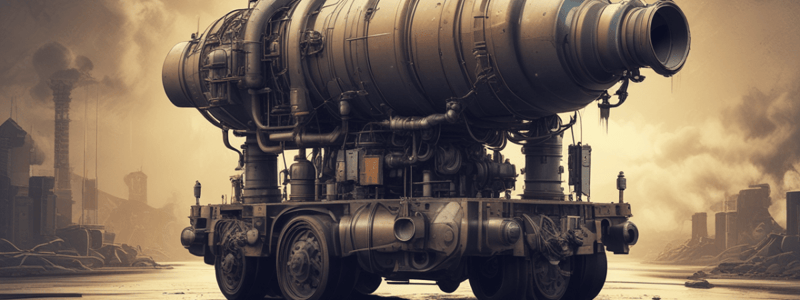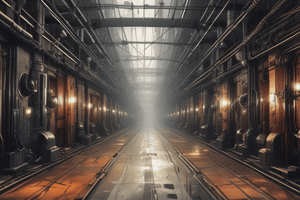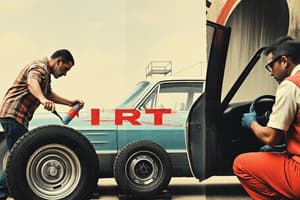Podcast
Questions and Answers
HVLP guns require compressed air to function.
HVLP guns require compressed air to function.
True (A)
Airless spraying is good for refined finishing.
Airless spraying is good for refined finishing.
False (B)
A pressure pot system is always required for HVLP guns.
A pressure pot system is always required for HVLP guns.
False (B)
HVLP guns produce a high-quality finish.
HVLP guns produce a high-quality finish.
A Siphon Feed spray gun uses gravity to feed the material from the container.
A Siphon Feed spray gun uses gravity to feed the material from the container.
Conventional Spray Guns are well suited for spraying both thin and thicker materials.
Conventional Spray Guns are well suited for spraying both thin and thicker materials.
Airless spraying uses compressed air for atomization.
Airless spraying uses compressed air for atomization.
HVLP guns can be used with shop compressors.
HVLP guns can be used with shop compressors.
The air cap, fluid tip, and fluid needle can be used interchangeably with different sizes.
The air cap, fluid tip, and fluid needle can be used interchangeably with different sizes.
Gravity Feed spray guns are more suitable for spraying thicker materials.
Gravity Feed spray guns are more suitable for spraying thicker materials.
Siphon Feed spray guns use less compressed air than Gravity Feed guns.
Siphon Feed spray guns use less compressed air than Gravity Feed guns.
The fluid needle opens the fluid tip to allow fluid flow.
The fluid needle opens the fluid tip to allow fluid flow.
The air cap determines the shape of the spray pattern.
The air cap determines the shape of the spray pattern.
Conventional Spray Guns have a large capacity, allowing for long spraying sessions without refilling.
Conventional Spray Guns have a large capacity, allowing for long spraying sessions without refilling.
The type of compressor required for spray finishing depends on the selected spray equipment.
The type of compressor required for spray finishing depends on the selected spray equipment.
A supply of clean, dry air is not required for many pieces of shop equipment.
A supply of clean, dry air is not required for many pieces of shop equipment.
Air compressors use a motor to compress air into a storage tank.
Air compressors use a motor to compress air into a storage tank.
Compressed air is released from the storage tank when the tank pressure reaches the upper pressure limit.
Compressed air is released from the storage tank when the tank pressure reaches the upper pressure limit.
The delivery rate of a compressor is typically stated in pounds per square inch (psi).
The delivery rate of a compressor is typically stated in pounds per square inch (psi).
Cold air can hold more water vapor than warm air.
Cold air can hold more water vapor than warm air.
Air at a high pressure can hold more water vapor than air at a low pressure.
Air at a high pressure can hold more water vapor than air at a low pressure.
When air is released from the storage tank, the air temperature increases.
When air is released from the storage tank, the air temperature increases.
A rotating gun will result in even coverage.
A rotating gun will result in even coverage.
Tipping the gun too far can cause the finish to cover the vent hole and dry, resulting in a smooth finish.
Tipping the gun too far can cause the finish to cover the vent hole and dry, resulting in a smooth finish.
Respirators can help protect against electrical hazards.
Respirators can help protect against electrical hazards.
Negative pressure respirators do not require fit testing.
Negative pressure respirators do not require fit testing.
Positive pressure respirators can be loose fitting or tight fitting.
Positive pressure respirators can be loose fitting or tight fitting.
SCBA respirators are powered by a battery-powered blower.
SCBA respirators are powered by a battery-powered blower.
Facial hair is not a potential issue with positive pressure respirators.
Facial hair is not a potential issue with positive pressure respirators.
A Cross Draft / Draft Through spray booth draws air from above and directs it out through filters located in the floor.
A Cross Draft / Draft Through spray booth draws air from above and directs it out through filters located in the floor.
A Down Draft spray booth has a low setup cost and low maintenance.
A Down Draft spray booth has a low setup cost and low maintenance.
A Waterfall / Waterwash spray booth has low setup cost and low maintenance.
A Waterfall / Waterwash spray booth has low setup cost and low maintenance.
A Make-Up Air Unit is used to provide cooled air to the spray booth.
A Make-Up Air Unit is used to provide cooled air to the spray booth.
Cheap filters are recommended for use in spray booths because they are more efficient.
Cheap filters are recommended for use in spray booths because they are more efficient.
Air velocity in a spray booth should be as low as possible to reduce energy consumption.
Air velocity in a spray booth should be as low as possible to reduce energy consumption.
Proper lighting in a spray booth is not important when applying a finish.
Proper lighting in a spray booth is not important when applying a finish.
It is recommended to store chemicals in a spray booth for convenience.
It is recommended to store chemicals in a spray booth for convenience.
Transfer Efficiency (TE) refers to the amount of material that is wasted during the spraying process.
Transfer Efficiency (TE) refers to the amount of material that is wasted during the spraying process.
Atomization is the process of propelling droplets toward a workpiece to coat it.
Atomization is the process of propelling droplets toward a workpiece to coat it.
Flashcards are hidden until you start studying
Study Notes
Overview of Spray Finishing and Touch-Ups
- Spray finishing involves equipment, materials, and techniques to achieve a desired finish
- The course includes both theoretical and practical components
Theory Topics
- Air compressors
- Spray booths
- Spray systems
- Viscosity
- Lacquer finish defects
- Rubbing a finish
- Shading stains and toners
Air Compressors
- Required for many shop equipment and spray finishing
- Types of compressors:
- Depend on the selected spray equipment
- Air compressors use a motor/air pump to force air into a storage tank
- Air amount in storage tank increases → Tank pressure rises
- Air amount in storage tank decreases → Tank pressure drops
Properties of Compressed Air
- Pressure (typically in pounds per square inch, psi)
- Delivery rate/flow rate (typically in cubic feet per minute, CFM)
- Storage volume (typically in gallons or liters)
- Humidity (air can hold water vapor, and pressure and temperature affect humidity)
Types of Air Compressors
- Environment protection from airborne products
Spray Booths
- Types of spray booths:
- Down draft (draws in air from above and directs out through filters in the floor)
- Cross draft/draft through (draws air from one end and out through a filter wall)
- Waterfall/water wash (uses a running sheet of water to capture overspray)
- Make-up air unit: introduces filtered and heated air to compensate for air exhausted by the spray booth exhaust fan
Filters
- Exhaust filters vary in quality and cost
- Important to allow a minimum CFM through the booth, depending on area
- Cheap filters can clog faster, reducing efficiency and allowing coating in the plenum and fan
Air Velocity
- Air must move through the booth with sufficient velocity to carry away overspray and toxic vapors
- Measuring and controlling velocity: use a manometer, adjust fan speed, pitch of blades, and air baffle on exhaust
Spray Booth Lighting
- Proper lighting is essential for applying a finish
- Reflections in the finish help assess evenness and defects
- Lighting must meet explosion-proof requirements for solvent-based finishes
Spray Booth Maintenance
- Monitor manometer and clean filters when required
- Keep lighting, floors, and walls clean and free of overspray
- Tidy up regularly, dispose of rags properly, and do not store chemicals or unnecessary items in the booth
Spray Booth Rules
- Wear proper PPE, including respirator masks
- No smoking, ignition sources, food, drinks, or contaminants in the booth
- Clean up thoroughly after use, including guns and chemicals
Spray Systems
- Definitions: overspray, transfer efficiency (TE)
- Basic operating principle: take liquid finish, break it up into droplets, and propel droplets toward a workpiece
- Creating droplets: atomization (breaking up bulk liquids into droplets)
- Making liquid flow: gravity, suction, pressurized container, or pump
Types of Spray Systems
- Conventional spray guns:
- Gravity feed
- Siphon (suction) feed
- Parts of a conventional spray gun: fluid tip/nozzle, fluid needle, air cap, and fluid tip
- Low-pressure spray guns: less overspray, higher TE
- Airless spraying:
- Does not require compressed air
- High-pressure diaphragm pump generates suction
- Not suitable for refined finishing, can produce 'orange peel'
Common Issues and Troubleshooting
- Even coverage: move the gun parallel to the workpiece
- Pulsating/fluttering: clean vent hole in cup lid
- Assessing issues: rotate air cap, inspect fluid tip/needle
Respirators
- Types: negative pressure, positive pressure, and SCBA (self-contained breathing apparatus)
- Selection based on type of hazard and level of exposure
- Negative pressure respirators: rely on wearer's lungs, tight-fitting, and require fit testing and seal checks
- Positive pressure respirators: push air to the hood or facepiece, can be loose-fitting or tight-fitting
Studying That Suits You
Use AI to generate personalized quizzes and flashcards to suit your learning preferences.




